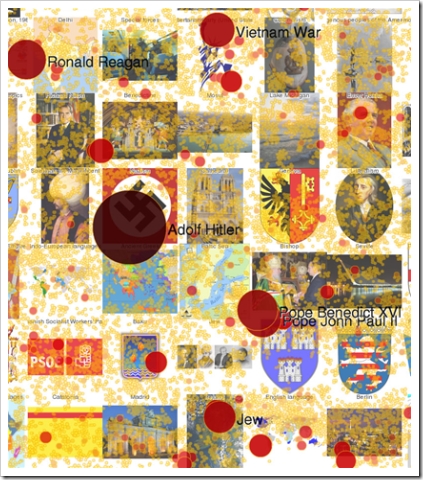Strange name, I know, but I’ll be interested to try one.
Daily Archives: October 14, 2007
The looming Google threat
Microsoft used to be the big threat, but it’s fading as the importance of the platform erodes. I’ve been saying for years that Google will be an even bigger public-policy problem than Microsoft ever was. Jeff Jarvis seems to agree and explains why:
Consumers, as we used to be called, won’t support media and journalism with their money. Advertising will. We will become entirely dependent on advertising. And what happens when Google controls the majority of online ad revenue in this country? They’re headed there, for as a TechCrunch commenter points out, Google’s online ad revenue and share of revenue are growing faster than online advertising as a whole.
On the one hand, we should be grateful to Google for enabling the support of much new media. On the other hand, we should fear
tehthe vice in which Google holds our privates. That’s where media power is consolidating — not in old conglomerates (some of which now depend for a good bit of revenue on who? — on Google.)I’m not blaming Google for getting to this point. Big, old media handed them this opportunity on a platter. Google was the one company that truly understood the economics of the open network. It understood that it could grow much bigger enabling than controlling. We in media should have followed that model. We should have asked WWGD. What would Google do?
So what do we do now? We need new networks that identify and create new marketplaces for new value — greater value than the coincidence of words on a page, which Google sells. We need to create our own high-value networks (e.g., hyperlocal news). We need open networks that compete with the closed aspects of Google; openness is water to the witch of an opaque network like Google’s.
That “iPod moment” meme
Jeff Jarvis has a forceful disquisition on “the iPod moment for newspapers”. He makes the point that the newspaper industry has for a long time assumed that its salvation lay in ‘e-paper’ — a flexible, foldable, high-res electronic display technology which would allow newspapers to continue as they were but with added e-power. Jeff’s view is that it ain’t gonna be like that, and I’m sure that he’s right. The new iPhone and iPod Touch devices are already pretty impressive as networked readers, and they will doubtless get better in the next couple of years.
I had an interesting discussion yesterday with Brian about the use of the term ‘iPod moment’. It’s slightly misleading because it implies that the appearance of a gizmo is the crucial event. Not so. The genius of the iPod was that it was paired from the outset with iTunes software — and that that software had a beautiful, intuitive interface. It was the combination of the two that made it simple for the average non-techie to manage compressed music files. There were lots of portable MP3 players before the iPod, but syncing them to a PC involved geekery to some degree and so was not for ordinary mortals.
So what really constitutes an ‘iPod moment’ is the instant when it becomes possible for the average consumer to engage in a practice that is terminally disruptive for an established industry.
Wikiwars visualised

This is a graphical visualisation of the 20 most hotly-revised articles in Wikipedia. The diagram comes from a fascinating article on how it was constructed. In essence, the authors used network theory:
We began this piece by representing the data as a network. In this case the nodes in the network are wikipedia articles and the edges are the links between articles. We then (with some help from our friends at Sandia) used an algorithm to lay out all 650,000 nodes (wikipedia articles) that had at least one link in such a way that similar articles are near one another. These are the yellow dots, which when viewed at low res give a yellow tint to the whole picture.
The sizes of the nodes (circles, dots, whatever you want to call them), are based on a model of revision activity. So large circles indicate that an article might be controversial, or the subject of lots of vandalism, or just a topic whose content frequently changes. We labeled only the largest nodes, to keep it readable. There is an interactive version of this in the works based on the google maps platform which will change the labels and pictures used as the user ‘zooms’ in or out. Stay tuned for that.
The image used for each tile was selected automatically, simply by using the first image in the most linked to article among all the articles in that tile. We were pleasantly surprised by the quality of the images that appeared.
Our hope for this visualization approach, which we continue to improve on, is that it could be updated in real time to give a macro sense of what is happening in Wikipedia. I personally hope that some variation of it will end up in high schools as a teaching tool and for generating discussions…
Vicious beasts and melting butter
This morning’s Observer column…
It is said that savage beasts are most dangerous when cornered. Cue the record industry, lashing out with increasing viciousness in its death throes. It’s been pursuing a policy of suing file-sharers, most of whom have settled out of court. But a court in Minnesota has been hearing the first of these cases that has actually come to court….
